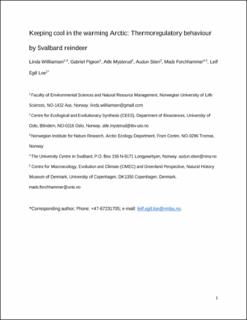Keeping cool in the warming Arctic: thermoregulatory behaviour by Svalbard reindeer (Rangifer tarandus platyrhynchus)
Williamsen, Linda; Pigeon, Gabriel; Mysterud, Atle; Stien, Audun; Forchhammer, Mads C.; Loe, Leif Egil
Abstract
In animals with long generation times, evolution of physiological and morphological traits may not be fast enough to keep up with rapid climate warming, but thermoregulatory behaviour can possibly serve as an important buffer mitigating warming effects. In this study, we investigated if the cold-adapted Svalbard reindeer (Rangifer tarandus platyrhynchus (Vrolik, 1829)) used cool bed sites as a thermoregulatory behaviour in the summer. We recorded habitat variables and ground temperature at 371 bed sites with random “control” sites 10 and 100 m distant. Using case-control logistic regression, we found that reindeer selected bed sites on cool substrates (snow and mire), as well as cold, dry ground on days with warm ambient temperatures, while they avoided such sites on cold days. Selection of both cool substrates and cool ground did not depend on age or sex. The study was conducted in an environment where neither predatory threat nor insect harassment influenced bed site selection. Our findings suggest that the thermal landscape is important for habitat selection of cold-adapted Arctic ungulates in summer. Thus, behavioural strategies may be important to mitigate effects of climate change, at least in the short term. bed site, behavioural buffering, climate change, habitat selection, snow, ungulates, Svalbard reindeer, Rangifer tarandus platyrhynchus.
